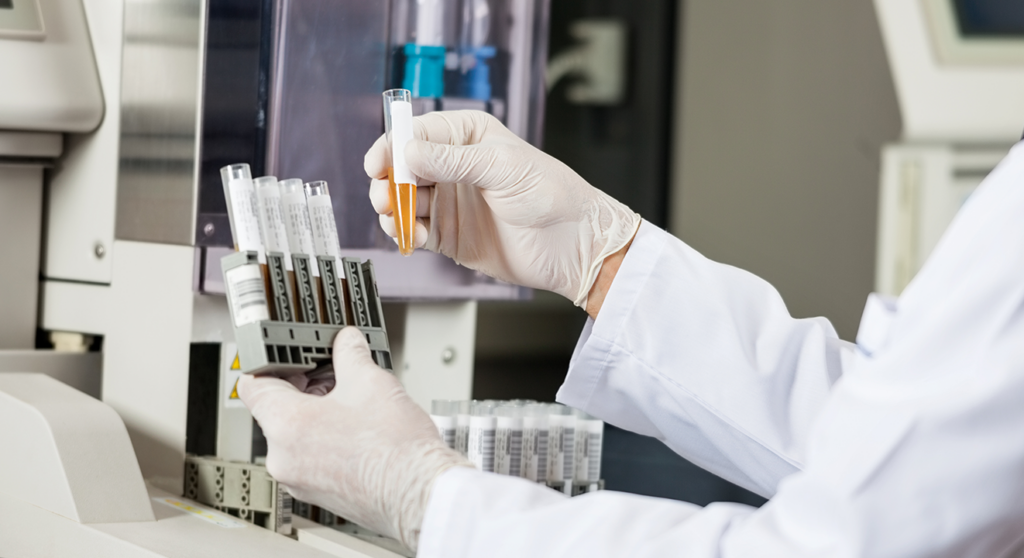
Methamphetamine, commonly known as meth, is a potent and highly addictive stimulant that impacts the central nervous system. It comes in various forms, like crystal meth, powder, and pills, and is known for its intense euphoric effects. Meth use can lead to serious health issues, including heart problems, severe dental decay, weight loss, and long-term cognitive damage.
This guide covers key information about meth detection in urine, including typical detection times, influencing factors, and the importance of addressing meth addiction. This knowledge is vital for those facing drug tests, detoxing, or seeking support for methamphetamine addiction.
What Is Methamphetamine?
Methamphetamine, commonly referred to as meth, is a powerful central nervous system stimulant. Chemically, it is classified as a synthetic stimulant and has a chemical composition of C10H15N.
Methamphetamine is classified as a Schedule II drug under the Controlled Substances Act, indicating it has a high potential for abuse but also has accepted medical uses under severe restrictions.
Meth is available in several forms, each with different methods of use. The most common forms include:
- Crystal meth: This is the most potent and commonly abused form, often resembling clear, chunky crystals or bluish-white rocks.
- Powder: A less potent form, meth powder is white or yellowish and can be easily dissolved in water or alcohol.
- Pills: Methamphetamine can also be found in tablet form, sometimes used legally in prescription medications for ADHD and certain cases of obesity.
Effects of Meth on the Body
Methamphetamine has profound effects on the body, primarily through its stimulation of the central nervous system.
- Central nervous system stimulation: Meth increases the amount of dopamine in the brain, leading to intense feelings of euphoria, increased energy, and heightened alertness. However, this overstimulation can result in dangerous physical and psychological effects.
- Short-term effects: These include an immediate sense of euphoria, increased heart rate, higher blood pressure, reduced appetite, and hyperactivity. Users may also experience increased wakefulness and physical activity.
- Long-term effects: Prolonged meth use can lead to severe health issues such as significant weight loss, severe dental problems (often called “meth mouth”), skin sores, and an increased risk of infectious diseases. Psychologically, chronic use can result in anxiety, confusion, insomnia, mood disturbances, and violent behavior. Users may also experience psychosis, including paranoia, hallucinations, and delusions.
Methamphetamine Use and Abuse
Methamphetamine can be ingested in several ways, each with varying impacts on the user and detection times in drug tests.
Common methods of ingestion include:
- Snorting: Inhaling meth powder through the nose provides a slower onset of effects compared to smoking or injecting.
- Smoking: This method delivers meth rapidly to the brain, producing an intense and immediate high.
- Injecting: Injecting meth directly into the bloodstream results in an immediate, intense euphoria and is associated with a high risk of overdose.
- Swallowing: Oral ingestion results in slower absorption and a delayed but longer-lasting high.
The frequency and amount of meth use significantly impact how long the drug remains detectable in the body. Frequent users are likely to have longer detection times due to the accumulation of the drug in their system. Occasional users may eliminate the drug faster. Factors such as metabolism, overall health, and method of ingestion also influence detection times.
How Long Does Meth Stay in Urine?
The detection window for methamphetamine in urine tests can vary based on several factors. Generally, meth can be detected in urine for one to four days after the last use. However, in chronic or heavy users, meth may be detectable for up to a week or longer.
Let’s take a look at how urine detection compares to other drug tests:
- Blood tests: Meth is detectable in blood for about one to three days after use. Blood tests provide a shorter detection window compared to urine tests.
- Saliva tests: Meth can be detected in saliva within a few hours of use and remains detectable for one to four days. These tests are often used for their ease and non-invasiveness.
- Hair follicle tests: Meth can be detected in hair for up to 90 days or more after use. Hair tests provide the longest detection window but do not indicate recent use.
Factors Influencing Detection Times
- Short-term vs. long-term use: The more frequently meth is used, the longer it will take for the body to eliminate it. Occasional users may clear meth from their system more quickly, while long-term users will have longer detection times due to the buildup of the drug in their system.
- Correlation with detection times: Larger amounts of meth result in longer detection times. Higher doses increase the concentration of the drug in the body, extending the time it remains detectable.
- The ingestion method: The method of ingestion affects how quickly meth enters and leaves the body. Smoking and injecting meth lead to faster absorption and a more intense high, but also tend to have a quicker elimination compared to snorting or oral ingestion.
- Overall health: A person’s general health, including liver and kidney function, impacts how efficiently the body can metabolize and excrete methamphetamine.
- Health conditions: Pre-existing health conditions can slow down the body’s ability to process and eliminate the drug.
- Metabolism: Individuals with a faster metabolism may process and excrete meth more quickly than those with a slower metabolism.
- Weight: Body weight and fat content can influence how long meth stays in the system. Methamphetamine is lipophilic, meaning it can be stored in fatty tissues.
Understanding Detection and Half-Life
The half-life of methamphetamine is approximately 10 to 12 hours. This means it takes this amount of time for half of the drug to be eliminated from the body. Understanding the half-life helps in estimating how long meth will remain detectable.
Meth is metabolized primarily in the liver and excreted through the kidneys in urine. The body breaks down meth into various metabolites, including amphetamine, which are then eliminated.
Urine tests detect both methamphetamine and its metabolites. The presence of these metabolites indicates recent use and helps determine the detection window.
Drug Testing for Methamphetamine
During a urine test, a sample is collected and analyzed for the presence of meth and its metabolites. This test is highly effective in detecting recent meth use.
Urine tests are considered reliable for detecting methamphetamine within the typical detection window. False positives are rare but can occur due to cross-reactivity with other substances.
Common scenarios for urine testing include:
- Employment: Many employers require drug testing as part of the hiring process or for ongoing compliance.
- Medical: Healthcare providers may test for meth use as part of a diagnostic process or treatment plan.
- Legal: Courts and legal systems often mandate drug testing for individuals on probation or involved in custody cases.
Understanding these aspects of meth detection is crucial for those undergoing drug tests and those seeking to manage or treat methamphetamine use and addiction.
Detox methods
The body naturally detoxifies methamphetamine through metabolic processes primarily occurring in the liver and kidneys. This involves breaking down the drug into metabolites that are eventually excreted through urine.
Here are some ways you can assist the body in detoxing meth:
- Hydration: Drinking plenty of water helps flush out toxins from the body and supports kidney function.
- Diet: Consuming a balanced diet rich in fruits, vegetables, and lean proteins can aid the detoxification process. Foods high in antioxidants can help repair some of the damage caused by meth use.
- Exercise: Regular physical activity boosts metabolism, which can help speed up the elimination of meth from the body. Exercise also promotes overall health and well-being.
Many believe that excessive water intake, detox drinks, or home remedies can significantly speed up meth elimination. However, these methods are generally ineffective and can sometimes be harmful. The most effective way to reduce detection times is through a healthy lifestyle, including proper hydration, nutrition, and exercise. Medical supervision is advised for those seeking to detox from meth, especially if they have a history of heavy use.
Methamphetamine Use Risks and Side Effects
The risks and side effects of methamphetamine use are extensive and can lead to life-threatening conditions.
- Physical health risks: Prolonged meth use is linked to serious health problems, including cardiovascular issues, liver damage, kidney failure, and respiratory complications. These conditions can be fatal if not addressed promptly.
- Mental health risks: Meth users often suffer from mental health issues such as anxiety, depression, aggressive behavior, and cognitive impairments. These mental health challenges can exacerbate the cycle of addiction and make recovery more difficult.
- Overall health and well-being: Meth abuse disrupts normal life activities, leading to social isolation, financial problems, and legal issues. The impact on overall well-being is profound, affecting personal relationships and the ability to maintain a stable and healthy lifestyle.
Recognizing Meth Addiction
Identifying meth addiction early is critical for getting the necessary help and support. Recognizing the signs and symptoms can lead to timely intervention and a better chance of recovery.
Signs and Symptoms
- Cravings: Individuals addicted to meth experience intense urges to use the drug, making it hard to concentrate on anything else. These cravings can dominate their thoughts and behaviors.
- Withdrawal symptoms: When not using meth, individuals may suffer from fatigue, increased appetite, depression, anxiety, and severe drug cravings. These withdrawal symptoms can make quitting extremely challenging.
- Behavioral changes: Addiction often leads to noticeable behavioral changes, such as increased secrecy, neglecting responsibilities, drastic changes in social circles, and engaging in risky behaviors to obtain meth. These changes can significantly affect an individual’s personal and professional life.
Recognizing these signs is the first step toward seeking help and beginning the journey to recovery.
Treatment options
Professional meth addiction treatment is needed to safely overcome and address both the physical and psychological aspects of dependence.
Types of treatment programs include:
- Inpatient treatment: Residential programs that provide intensive care and support, including medical supervision, therapy, and counseling.
- Outpatient treatment: Programs that allow individuals to live at home while attending treatment sessions regularly. Suitable for those with a supportive home environment.
- Detox treatment centers: Facilities that offer medical detoxification services to help manage withdrawal symptoms and prepare individuals for further treatment.
The Substance Abuse and Mental Health Services Administration (SAMHSA) provides resources and support for individuals struggling with substance abuse. They offer a national helpline and an online treatment locator to find local services.
Support groups, such as Narcotics Anonymous (NA), provide a community of individuals who share similar experiences and offer mutual support. These groups can be an integral part of the recovery process, helping individuals stay motivated and connected.
Understanding these aspects of meth use, detox, and treatment options is essential for anyone affected by methamphetamine addiction, whether directly or through a loved one.

Understanding Meth Detection and Seeking Help
Methamphetamine can be detected in urine for up to four days, depending on the frequency of use, amount consumed, and individual health factors. Recognizing the signs of meth addiction, such as intense cravings, behavioral changes, and meth withdrawal symptoms, is vital for seeking appropriate help.
Professional addiction treatment is crucial for overcoming meth dependence and addressing both the physical and psychological aspects of addiction.
If you or a loved one is struggling with meth addiction, seek professional help. Boca Recovery Center offers specialized programs with dedicated medical professionals to support individuals on their recovery journey. Contact Boca Recovery Center today to start your path to recovery and reclaim your life from meth addiction.



